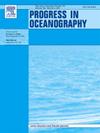Nutricline heaving regulates carbon export in the South China Sea
IF 3.6
3区 地球科学
Q1 OCEANOGRAPHY
引用次数: 0
Abstract
The export of phytoplankton-synthesized particulate organic carbon (POC) from the upper ocean to the depth removes CO2 from the atmosphere, playing a critical role in the global climate system. However, substantial data and knowledge gaps in the spatial and temporal variability of the POC export hamper a full spectrum of understanding to the controls of POC export at both seasonal and basin scales. Here, we developed an optimized one-dimensional biogeochemical model, which well simulates the seasonal variations of biogeochemical parameters at the South-East Asia Time-series Study station in the South China Sea (SCS). Applying this model, we further examined the climatology of POC fluxes in the SCS using a high-quality nutrient dataset derived from an algorithm based on a relationship between field observed nutrients and temperature/salinity with high spatiotemporal coverage. The POC fluxes at 100 m deep range from 0.24 to 12.7 mmol C m−2 d−1 and exhibit evident spatial and seasonal variations. During the summer (from June to August), the POC fluxes in the northern and northwestern SCS regions are higher compared to the central and southern SCS regions. In winter (from December to February), the POC fluxes in the northern SCS are significantly enhanced. Overall, the northern and western basins exhibit higher POC fluxes compared to the central and southeastern basins in all four seasons. Seasonally, the basin averaged POC fluxes in spring and winter exhibit higher values than that in summer and fall. At the relatively eutrophic regions where surface nitrate (NO3−) concentrations > 0.1 μmol L−1, the surface NO3− concentrations are the primary factor influencing the distribution of POC fluxes, particularly in winter and in the northern SCS. In contrast, within the vast oligotrophic environment, the subsurface nutricline heaving driven by upwelling/downwelling induced by horizontal convergences/divergences at both meso- and basin scales, plays a pivotal role in determining the distribution of POC fluxes. Our findings underscore the significance of subsurface nutricline heaving in driving carbon export in the oligotrophic ocean.
海底起伏调节着南中国海的碳排放
浮游植物合成的颗粒有机碳(POC)从海洋上层向海洋深处输出,去除大气中的二氧化碳,在全球气候系统中起着至关重要的作用。然而,在POC输出的时空变异性方面存在大量的数据和知识缺口,阻碍了对季节和流域尺度上POC输出控制的全面理解。本文建立了一个优化的一维生物地球化学模型,较好地模拟了南海东南亚时间序列研究站生物地球化学参数的季节变化。应用该模型,我们进一步研究了南海POC通量的气候学,使用高时空覆盖的高质量养分数据集,该数据集基于田间观测到的养分与温度/盐度之间的关系。100 m深POC通量范围为0.24 ~ 12.7 mmol C m−2 d−1,具有明显的空间和季节变化。夏季(6 ~ 8月),南海北部和西北部地区的POC通量高于南海中部和南部地区。冬季(12 - 2月),南海北部的POC通量显著增强。总体而言,北部和西部盆地四季的POC通量均高于中部和东南部盆地。从季节上看,春季和冬季盆地平均POC通量高于夏季和秋季。在相对富营养化区,地表硝酸盐(NO3−)浓度>;0.1 μmol L−1时,地表NO3−浓度是影响POC通量分布的主要因素,尤其是冬季和南海北部。相反,在广阔的少营养环境中,由中尺度和盆地尺度的水平辐合/辐散引起的上升流/下升流驱动的地下营养线起伏对POC通量的分布起着关键作用。我们的研究结果强调了地下营养线起伏在驱动低营养海洋碳输出中的重要性。
本文章由计算机程序翻译,如有差异,请以英文原文为准。
求助全文
约1分钟内获得全文
求助全文
来源期刊

Progress in Oceanography
地学-海洋学
CiteScore
7.20
自引率
4.90%
发文量
138
审稿时长
3 months
期刊介绍:
Progress in Oceanography publishes the longer, more comprehensive papers that most oceanographers feel are necessary, on occasion, to do justice to their work. Contributions are generally either a review of an aspect of oceanography or a treatise on an expanding oceanographic subject. The articles cover the entire spectrum of disciplines within the science of oceanography. Occasionally volumes are devoted to collections of papers and conference proceedings of exceptional interest. Essential reading for all oceanographers.
 求助内容:
求助内容: 应助结果提醒方式:
应助结果提醒方式:


